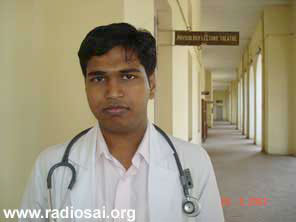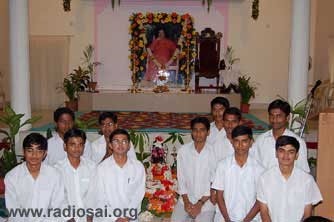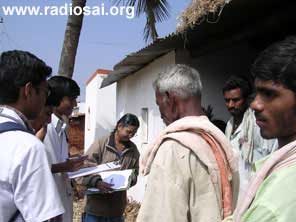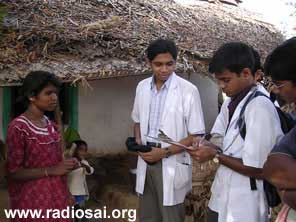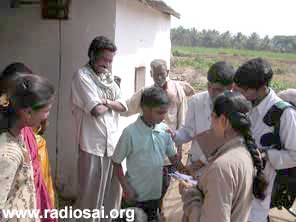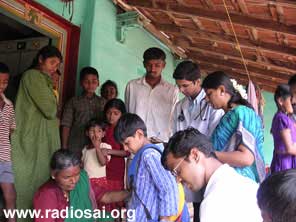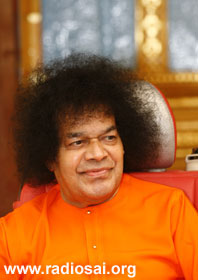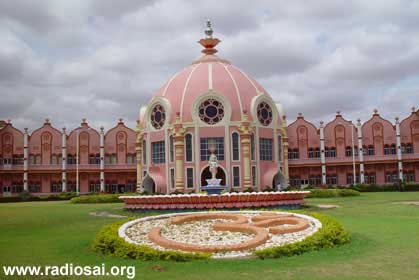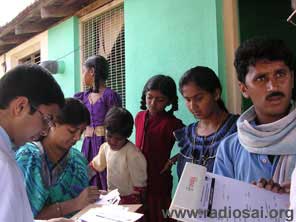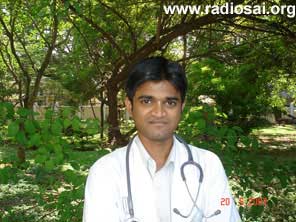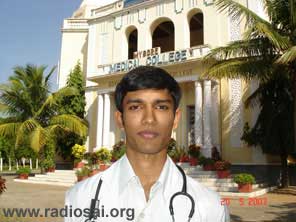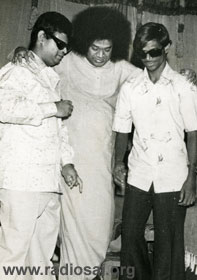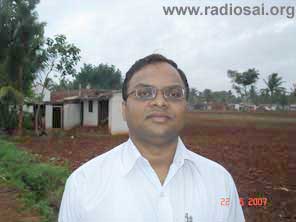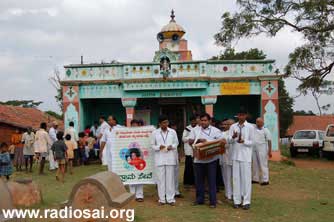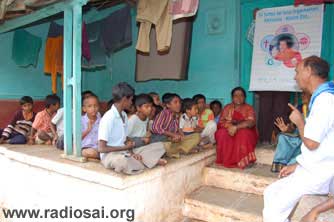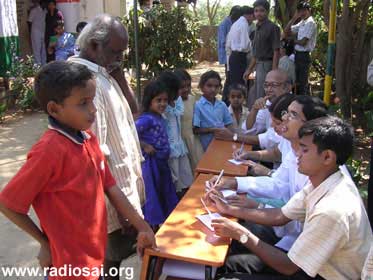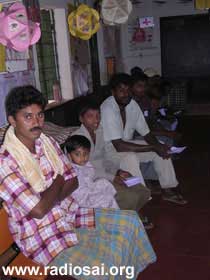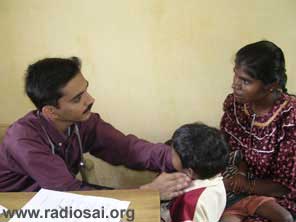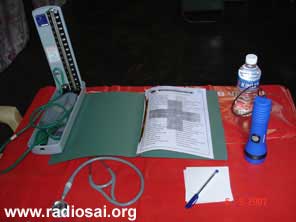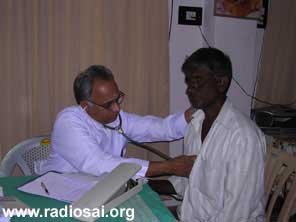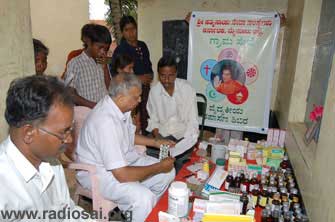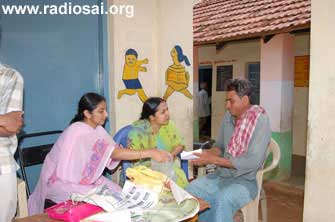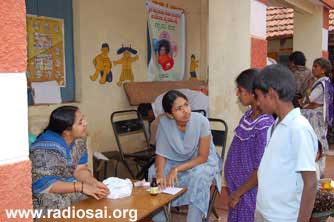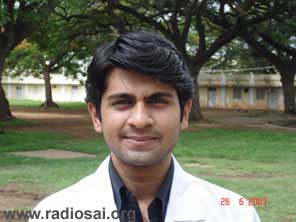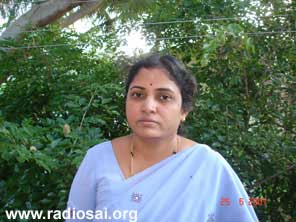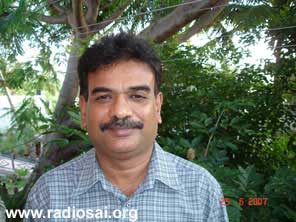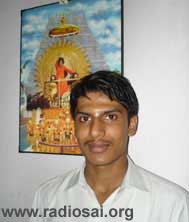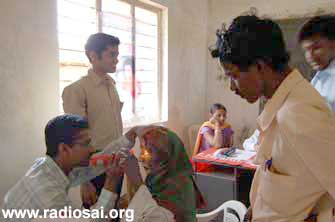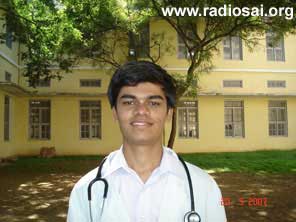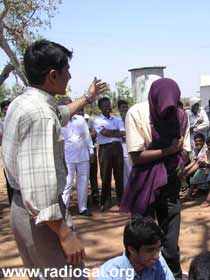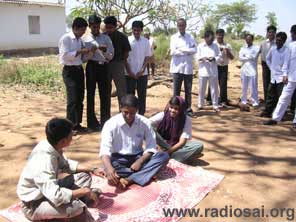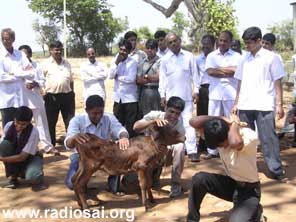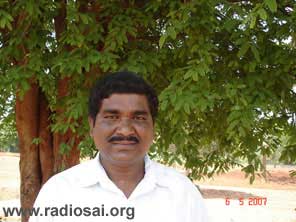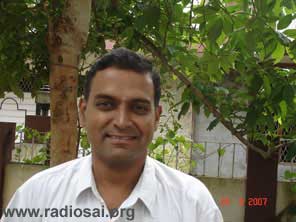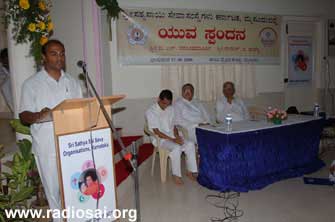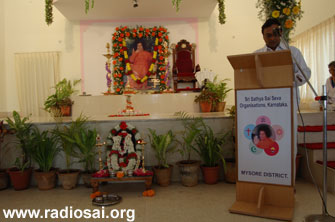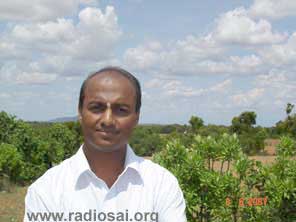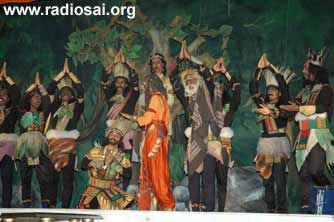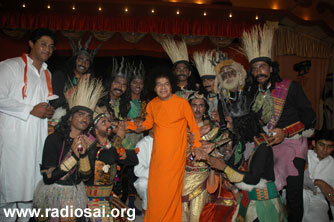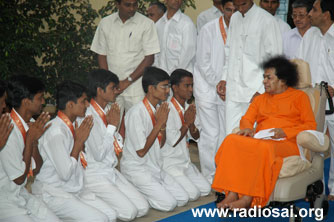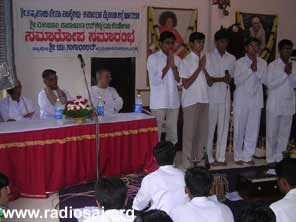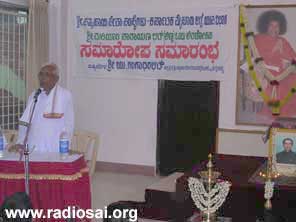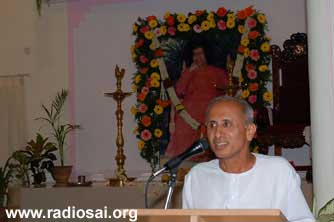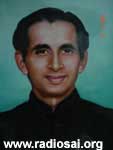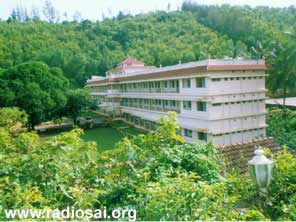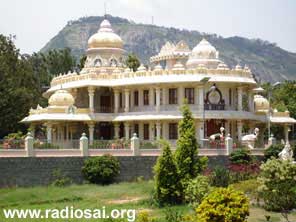Effective Healthcare Seva
A Project Management Perspective to Medicare
In the May issue of H2H, we brought you the story of a massive medical camp conducted in the Sai School in Alike that was executed beautifully to the satisfaction to everyone – patients, doctors, volunteers, etc. - whoever was part of it, thanks to the dedicated band of students of the school who literally took over the whole service camp. [To read that story again, click here]. If that was wonderful, what we have in the current article is even more stirring. This is the story of the splendid steps taken by the former students of this blessed school along with other Sai Youth in trying to bring lasting and profound change in the lives of the forlorn and deprived.
“History is HIS Story”, saying these words Swami greeted a group of rank students from Sri Sathya Sai Loka Seva Educational Institution, Alike (pronounced as a-lee-kay), located about 50 kms from Mangalore in the Indian state of Karnataka.
These students, by His Grace, had created a record by securing first rank in Common Entrance Test (Medical), Common Entrance Test (Engineering) and First Rank in Karnataka State Pre-University Examination. A unique and historic feat indeed! The batch of year 2003 had also created a record by securing 35 ranks in the top 100 bracket in Common Entrance Test for Engineering and Medical colleges.
Boys with ranks 1, 2, 5, 6 and 11 in Medical Entrance Examination and Ranks 1 and 5 in Engineering Entrance Examination were present in the immediate presence of Bhagavan along with Sri U Gangadhara Bhat, the Chairman and other elders of the Sri Sathya Sai Loka Seva Educational Institutions (SSSLSS) that Swami had most lovingly taken over in 1978.
Alike Students’ Amazing Performance
In the interview that Bhagavan gave the students on that memorable day, He emphasized the role of healthcare seva in society. What the boys did not know then was that the all-knowing Lord had already planned their future well in advance! In August 2003, 16 boys from Class 2003, SSSLSS, joined the prestigious Mysore Medical College and Research Institute . Today they are studious final year students and training to be pioneers as doctors and administrators in healthcare domain. But what is more heartening is that they are now dedicated members of the Sai Youth Wing too in the city of Mysore, the second largest in the Indian state of Karnataka, located about 135 kms from Bangalore. |
|
|
|
|
Immediately after arriving in Mysore in 2003, they searched for a Sai Samithi and to their surprise they found a newly inaugurated Sri Sathya Sai Seva Kshethra (blessed by Bhagavan in March 2003) which was just a kilometer away from their Medical College Boys Hostel. They responded immediately by attending bhajans on every Thursdays with a lot of devotion and enthusiasm. Soon, they were part of the Sri Sathya Sai Youth Wing, Mysore district. Sri Avinash S, a former student of the Alike School, says,
“Based on Swami’s advice, we approached the Youth Coordinator of Sri Sathya Sai Organization, Mysore District, Sri M. Prasaad and expressed our willingness to participate in healthcare seva activities. He immediately requested us to join his team. The real excitement began when we were given the task of providing the healthcare perspective of Grama Seva.”
|
Avinash S, a former rank student of the Alike School |
|
|
Taking the First Few Steps…
The team was informed that as a part of the new initiatives, healthcare seva activities would be treated as a priority area. This meant more villages will have to be included in the healthcare seva agenda. With medical students inducted into the team, the atmosphere was charged with optimism and enthusiasm. Youth Wing and experienced Seva Dal members (including the members of the current Healthcare Seva team) gathered to develop a preliminary roadmap.
The medical students provided valuable insights while the experienced members explained the ground realities of the villages in Mysore district. The blend of youth and experience helped the team to visualize the healthcare seva more effectively. Despite all these, goals appeared very difficult to achieve, initially. There were many seemingly insurmountable goals. The youth prayed for His inspiration and what evolved then is an effective three-phased approach to Healthcare seva.
The first step in this whole process was the Data Gathering phase; next, the Planning phase; and finally the Implementation phase. The youth knew that, to being with, they needed comprehensive data pertaining to the various health parameters of the village. A thorough medical survey was, in fact, the need of the hour to ensure that the service camps are effective and deliver exactly what is most needed. |
|
|
|
Former Alike boys ready for His mission |
Based on the expert judgment and advice of the senior members, seven villages were selected for a preliminary survey, out of which two villages, they decided, would be short listed for comprehensive medical survey and subsequently healthcare Seva.
Visiting the Villages
Detailed discussion resulted in the preparation of a list of parameters that broadly provide a snapshot of the prevailing conditions in a village, and this was called the Initial village survey list. The information collected from each village included the following -
- Approximate population distribution
- Condition of the approach road
- Transportation facilities
- Nearest medical infrastructure
- Prevalence of endemic or epidemic diseases
- Availability of drinking water
- Adequacy of water supply and water source details
- Condition of Sanitation
- Availability of power supply
- Level of health awareness among people
- Literacy rate
- The condition of village school
- Socio economic status
- Number of people below the poverty line
- The condition of village temple
|
|
|
Collecting vital statistics from seven chosen villages personally
|
The team visited all the seven villages and gathered the information. The analysis of this data helped the team to define the basic criteria to select the village for health status survey (and subsequently medical camps). They now laid down six basic criteria for selecting the villages to do Medical Camps:
- Majority of people below poverty line
- With minimal healthcare infrastructure; no primary health center in radius of 5-10 Km
- Poor literacy rate
- A population with poor awareness in health and wellbeing
- People harboring endemic diseases
- Not well connected / no good roads
|
|
|
Nobody was excluded - the old or the young |
|
Meticulous planning went into data collection |
Can Serving Few Villages Solve all the Problems?
For the youth, surveying the villages was a revelation. The lack of basic amenities and the poor level of awareness among villagers changed the perceptions of the youth members. Every one agreed that there is a lot of work to be done. The quantum of work would in fact, require more than a lifetime! Some started even questioning the whole effort: ‘How can few youth participating in healthcare seva activities twice a month, bring about transformation? The answer that came drawing inspiration from Swami’s teachings was: “You are just an instrument in the hand of the Divine Master and you serve yourself by serving others.” Some of the youth still were not convinced; they said, “This is difficult to digest. Can we have a more practical, simple and understandable answer?”
And the clarification they wanted emerged after a few weeks during the course of the healthcare seva activities. All in unison agreed that “it is quite difficult to achieve even the smallest milestones in seva projects, but Swami has brought about so much of transformation and progress in such a short span of time. How could Swami build the massive Super Specialty Hospital in ten months? The answer clearly lies in Swami’s approach. By participating in seva projects, we learn how to manage time, resources, situations and expectations. This skill makes us effective in our career, home and just about where ever we go.
|
|
|
The Divine Manager |
|
His splendid creation...The Super Specialty Hospital in Puttaparthi |
“A volunteer, for example, may be given a task at food distribution counter in the village. Just standing at the counter he can do a lot more. He can calculate the time spent by each recipient in the queue. He can assess if the quantity of food is sufficient? Are there any alternatives if there is a shortage of food? Is the food being served properly in a hygienic way? Is the recipient happy? What would be the checklist for food counter? What are the other requirements in terms of time, resources and expectations? Finally, what are the expectations of the Divine Master Himself?”
So effectively, every task becomes a confluence of duty, devotion, dedication, determination and discrimination along with project management, task related skills, expert judgment, continuous knowledge update and progressive improvement in quality.
It enhances the way seva projects are managed. It also results in the personality improvement and creates greater balance in life. It increases the emotional quotient, self confidence and self esteem. The volunteer also learns to do his duty and leave the rest to God (though not an easy task to do always!). One should do the work to the best of their abilities and avoid having grandiose plans like eradicating a disease from the face of the planet … It is good to have ambitious goals as long as it is practical and achievable. In the end, being effective Sai Youth, apart from the obvious personal growth, is a passport for professional growth too! As we approach the state of excellence, we begin to see God everywhere. We attain the state of MBA (Mind in Baba Always)”. To put in a nutshell paraphrasing Swami’s words, “You are not serving in order to solve the problems; you are serving in order to make an offering to God and to improve yourself.”
The youth were now very clear about the ‘why’ of their activities. The discussion next was on the ‘how’. “We need to develop standard seva methodologies,” they agreed. Soon, the team seriously incorporated the Project Management guidelines alongside medical domain knowledge into the Sai Healthcare activities.
And the first step in this approach was the Data Gathering Phase.
I. Health Status Survey - Data Gathering Phase
Health status survey marked the beginning of data gathering phase. Earlier we saw how the youth selected six basic criteria to select the villages for Seva, now they conducted a full fledged health status survey in these villages in order to gather inputs on the prevailing health status scenario in these hamlets. Principally, they sought to draw the village health profile by finding out the following about the village -
- Endemic & epidemic diseases,
- Prevalent chronic diseases
- Diseases that require immediate care.
- Nutritional status
- Level of health awareness – Knowledge, Attitudes and Practices [KAP Assessment] of the people towards the disease
- Disease foci - pinpointing the cause of diseases (for example, contamination of drinking water source, poor sanitation, etc.)
|
|
|
The first vital task in the whole process - visiting the villages and collecting data first hand about the villagers' health profile
|
During the survey, as the medical students in the team were looking for signs of malnutrition, chronic disease, anemia, and the like, they discovered that one of the villages was actually having an epidemic of Chikungunya (a viral disease)! Similarly, in some villages the sanitation system was appalling.
They used various established procedures and techniques to collect the information. For example, the nutritional status of children below five years of age was assessed by measuring the mid arm circumference.
What Kind of Data Did The Survey Reveal?
It gave valuable information on many aspects like -
- Gender wise, Age wise, disease wise breakup of the population
- Immediate requirements (urgent health care problems)
- Priority areas
- Villagers’ response to the proposed camp
- Local resource persons
- Site where the camp can be conducted
- All the input data to plan a camp effectively like
- Type of camps required
- Number of patients expected
- Number of doctors and specialists required
- Type of medicines required ( guess estimate based on the disease profile)
- Quantum of medicine ( guess estimate)
- Medical instrument requirement
- Level of Awareness
- Level of Hygiene
- Infrastructure improvement required (like water supply, sanitation, etc.)
- Social and cultural imperatives
- Manpower requirements
- Budget allocation
|
|
Sharing his experience about the survey, Sri Ravishankar P M, a former rank student of Alike, says,
“After preliminary visit, we conducted a health status survey so that the information would help in defining the objectives of the medical camp. Survey gave us first hand information of the problems faced. During the clinical postings, medical students have to gather and analyze the case histories of the patients. Our experience in designing the village survey, analyzing the data and deriving conclusions gave us an upper edge in clinical postings and, apart from the chance to do Sai Seva, also helped us to get more marks in the corresponding exams.”
|
Sri Ravishankar P M, a former rank student of Alike |
|
|
For Kuldeep Shetty S, another rank Alike alumnus, personally collecting data from the villages was a revealing experience. He says,
“Visiting the villages was an eye opener to us, especially the medical students. Villages lacked basic hygiene. People were ignorant of health issues and blissfully were not bothered about its impact too.
There was no immediate infrastructure to treat the villagers, no disease prevention framework and nobody to create awareness in healthcare, hygiene and well being. We started analyzing the healthcare status of the village and tried to express it in terms of Treatment, Prevention and Awareness requirements.”
|
|
|
| |
|
"Visiting villages was an eye-opener" - Sri Kuldeep Shetty, another rank Alike alumnus |
II. Brainstorming - The Planning Phase
After data collection, this next stage of Planning was surely the most decisive phase. The first brainstorming session among the youth did throw up many possibilities but no conclusion could be reached. It was the case of ‘newer solutions bringing in newer problems’. The suggestions were varied, from daily nutrition scheme to combat malnutrition; eliminating the usage of alcohol and tobacco to fluoride removal from drinking water; conducting medical camps frequently to improving sanitation status, etc. To accommodate everyone’s ideas meant complete disarray of the whole healthcare implementation plan. Even though the team agreed to disagree on many issues, love and mutual respect prevailed under all circumstances. They knew they needed an ‘out of the box’ solution and prayed for Divine guidance.
Lead coordinators now revisited the entire exercise and developed a model based on the health status survey data. They decided to classify all the requirements of the village into what is required immediately, what can be implemented over next eighteen months and what can be implemented in a time span of a few years. Such classified and phased approach fitted perfectly with the Treatment – Prevention - Awareness model proposed by the medical students.
This meant that immediate priority (Treatment) is to detect diseases and provide treatment to all diseases in the village. Over next eighteen months (Prevention) the team aimed at implementing preventive measures systematically which included comprehensive vaccination (as per national immunization schedule), improving sanitation in the village, encouraging hygienic practices among villagers and creating disease prevention related awareness. Finally, the Long term initiatives (Awareness) included sustained awareness campaigns along with infrastructure upgrade to improve the quality of life in the village. And added to this was the Spiritual Dimension which kept all the activities in the right perspective.
With this framework it was possible to accommodate all the suggestions over a period of time. It also improved the team spirit because each member felt that their individual point of view was accommodated in a collective framework of ideas and plans. This increased the belongingness of each member to the team.
The progress achieved so far was summarized as -
Swami’s teachings + Project management methods + medical domain knowledge + sincere and dedicated implementation of seva activities + Swami’s blessings = Quality seva delivered + Problems resolved + Swami’s Grace + Personality development + Knowledge improvement + Career Growth + Spiritual growth + Job satisfaction + Joy
To view the key components of a healthcare camp, click here |
During the survey the team encountered a story which reflected the prevailing scenario in most of the Indian villages. This story in fact, influenced the team to redefine the camp methodology.
Nanjaiah, a 40 year old illiterate farmer who was the sole bread winner of the family, visited a doctor in the neighboring village when his fever persisted even after ten days. The doctor there gave him Paracetamol and referred him to the district hospital for a blood test. Typically, persistent fever requires further investigation, but Nanjaiah ignored the doctor’s advice as going to the district hospital would cost his family a day’s wage. The fever now persisted for a longer duration and soon, his condition became life threatening. Finally, one day when it became a question of life and death, he was brought to the district hospital. Nanjaiah was actually suffering from typhoid initially (a water borne disease) which progressed to intestinal perforation, requiring emergency remedial measures.
From this story the team analyzed that the outbreak/spread of typhoid could have been avoided by:
|
|
- Availability of Safe drinking water [Prevention/ Infrastructure development ]
- Following doctor’s advice for further investigation. [Awareness/follow-up/referral]
- Proper sanitation to contain the outbreak of waterborne diseases. [Prevention/ Infrastructure development]
- Personal Hygiene & Cleanliness [Awareness]
- Timely Availability of medical facilities. [Infrastructure development/regular medical camps]
- Proper review of the medical condition through regular follow-ups. [Awareness/follow-up/referral/ regular medical camps]
- Managing referrals for advanced investigation/treatment. [Referral / follow-up]
- Counseling of the patient (to drink clean water) [Awareness]
- Emergency case handling. [Situation management/Prevention]
From this experience, the team was able to clearly crystallize their objectives and their effective action items for subsequent activities. Now apart from the earlier three – Treatment, Prevention and Awareness – the team added two more facets – Infrastructure and Transformation - which made the mission of the Healthcare Seva a comprehensive five-point program. |
Water - the source of life |
|
|
Objectives of Healthcare Seva
Treatment: Heal the body and mind.
Prevention: Take steps to prevent further spreading of diseases. Aim at elimination of disease occurrence over a longer term.
Awareness: Health, hygiene & the correct way of living towards positive health.
Infrastructure: Help the underprivileged by developing the physical infrastructure and in the process develop the infrastructure in the heart to support and nurture divine feelings.
Transformation: Transform the sick and the decrepit villages into healthy, happy, vibrant and self sufficient villages full of harmony and wellbeing. For this to happen, the sevadal youth should also initiate the transformation in their respective hearts as well.
The spiritual metaphor of the all objectives simply is “Love All, Serve All”. Swami says, "Tablets alone cannot cure pain and medical equipment is powerless in the face of hopelessness. Primary health care is complete only when the broken body is mended and the forlorn spirit restored. It is only when the tears have been wiped away and hope restored that the health care delivery can be deemed complete.” |
|
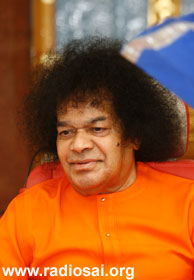
|
To view a diagram of the core areas of medical camp, click here |
How to Balance Family, Service and Office?
The team together was now generally convinced of the big picture evolved so far, but still there were few teething problems. Some members due to other commitments were unable to give more than four hours a month; they felt de-motivated. Here, the team leadership convinced them that the four hours of their time was very precious for the team, and moreover, it is the quality of work not quantity that mattered most.
Office and family commitments are facts of life and seva activities become more effective only when office and family situations are balanced. So, the senior youth members advised that one should focus more on achieving balance rather than count the number of hours in service. By careful planning and thinking, one can surely take time out for seva activities which will eventually act as a catalyst to speed up transformation (individually and collectively). A balance in all spheres of life is possible only through transformation.
It may not have been the best answer, it was convincing nevertheless. Many members still had questions about job rotation, skill sets, self goals vs. team goals, etc. It turned out that everyone was looking for a point of confluence of everyday life, spirituality, role as an individual and role as a team member.
Here, the team did a detailed study and interpretation of Swami’s teachings and restated some of the action items and keywords within the context of the Youth Wing activities.
Action items from an individual and team context were:
- create Impact
- use Best Practices
- improve Standards
- adopt Modern innovation
- implement Ancient wisdom
- embrace Change
- gather Data
- utilize Statistics
- redefine Sadhana
|
|
And the keywords applicable to the context distilled into:
- Pray
- Serve
- Transform
- Surrender
- Think
- Plan
- Act
- Manage
- Deliver
|
The individual roles were redefined as administrator, budgeter, planner, negotiator, organizer, communicator, manager, mediator, supervisor, leader, etc.
The team at this stage also developed detailed seva implementation plan with objectives, milestones, activity breakup, task details, scheduling, guidelines and checklists, etc. This helped the team to manage the entire healthcare seva activities more systematically and manage the resources more optimally and effectively.
To view the a sample of the Healthcare Seva Implementation diagram, click here |
Defining Priorities – What Kind of Medical Camps to Concentrate on?
Based on the analysis of data of the Village health profile and ground realities of villages, the team developed a list of priority areas for healthcare seva. These critical health concerns were juxtaposed against the constraints (in terms of what was practically achievable) and what emerged was a list of nine priority camps/programs:
- General Medical Camp
- Special Camp for Women & children
- De-Worming camp
- Ophthalmology camp
- Dental camps
- Nutrition program
- MMR vaccination for children
- Cancer and TB screening
- Cleanliness and sanitation
The statistics also revealed that women and children needed special emphasis in the healthcare activities because -
|
|
- Women and children form up to 70% of the population.
- They are the most vulnerable section of the society.
- Women are great communicators. If they transform, society transforms.
- If Women lead a better quality of life, children grow up to be better citizens.
- If Children are healthier today, future is healthier and better.
So, it was decided to have camps exclusively for women and children. While these inferences were developed with statistics localized to Mysore, the youth feel they are generally applicable to most of the villages in India. They also included urban areas in the healthcare activities map where the focus is more on lifestyle diseases like diabetes and hypertension. For the cities and towns, they included blood donation camps too in their list. |
This important phase of planning resulted in development of the objectives, action plans, task details, checklist schedules and costing models for each of the camps which have become extremely useful while conducting camps, be it regular or sporadic depending on the need. Talking about the usefulness of this activity, Sri Sathyanarayana Murthy, Coordinator of the Sri Sathya Sai Youth Wing, Mysore, says,
“Planning and conducting Healthcare camps using these methodologies in villages taught us superior project management skills. Personally it taught me to be more systematic which in turn improved the quality of work professionally. My positive outlook resulted in my office staff participating in Seva activities. They are now a part of the Sai Family with significant improvement in their personalities as well. There is real all round transformation after participating in Sai Healthcare Seva.”
|
|
|
| |
Sri Sathyanarayana Murthy, Coordinator of the
Sri Sathya Sai Youth Wing, Mysore |
III. Health Care Camp in Action - Implementation Phase
In this last stage, the team decided on the nitty-gritty of conducting a medical camp starting from camp layout to patient follow up and referral camps. They laid down clear guidelines for each activity in an actual medical camp. To begin with, they said that the lay out of the camp should facilitate a streamlined flow of people from entry to exit points. This sometimes might require imaginative thinking and experience in crowd control but this is important as bad layout would create confusion, disharmony and make the medical camp activities inefficient.
It is great to start the medical camp by first creating positive vibrations in the village by spiritual activities like group singing, chanting hymns, etc. It brings the villagers together and also adds more vigour to other value-addition activities like Bal Vikas, Study circle, etc. being done in the villages by the members of the Sai Organisation.
|
|
|
Starting the camp with a positive note... |
|
Reinforcing values at every available opportunity |
Registration
A patient enters the camp, through the registration section. This is an important area from the impression and perception management perspective. The patient and the accompanying people have to be greeted and invited into the camp. Volunteers managing this section should be cheerful, polite, helpful and informative. They should provide a correct and context sensitive answer to every query. If they are not sure they should ensure that some one more knowledgeable handles the query. There is no harm in requesting the patient to wait for a while till someone else provides the correct answer. It is also a very good idea to give the patient some idea of the camp procedures. The crucial thing to remember for every volunteer is that they are actually interacting with a manifestation of ‘Sai Narayana’ in the form of the patient.
Every patient is given a case book that contains his personal details like name, age, gender, address, etc. This book is used by the doctors to maintain the case history of the patient. The patients are requested to return it so that the healthcare team updates all the information into a database for further reference by doctors. This data would be very useful for statistical analysis like the frequency of disease occurrence, the duration of treatment, healthcare costs per person, etc. which will help in taking right decisions.
|
|
|
Collecting the patients' details patiently |
|
Comfortably waiting to be seen |
Waiting area
After registration, patients are seated in the waiting area, which should typically accommodate about twenty people comfortably (unless of course it is a big camp). This area could be made more ambient by playing soothing instrumental music. Pictorial charts displayed here demonstrating personal hygiene, sanitation, immunization, nutrition, awareness about major diseases, hazards of smoking, alcohol and drug abuse would be an added advantage. Volunteers to handle queries and availability of drinking water and washroom facilities here are a big plus.
Checkup area
The checkup area is typically a room with good lighting and ventilation. Cleanliness in this room is an essential prerequisite. It must have an examination couch with a screen to provide privacy.
|
|
|
Consultation with care |
|
Patient and the doctor - both should feel 'at home' |
Doctors here are to be provided with the minimums ancillaries like BP apparatus, weighing machine, torch, pen, paper, a box of tissues, surgical spirit or hand sanitizers and a list of the medicines (and quantity) available at pharmacy counter.
|
|
|
The doctors kit that should be on every table |
|
Facilitating a comprehensive check up |
Pharmacy
Pharmacy is tasked with medicine distribution as per prescription. It is typically managed by a pharmacist but volunteers need to explain the dosage to every patient in detail in their own language. Pictorial description of dosage and medicine usage is an added advantage.
|
|
|
Trained pharmacists to dispense medicines... |
|
...and volunteers to reiterate the dosage |
Counseling
The dosage, the timing and the way in which medicines have to be taken is explained again in this stage. Doctors and volunteers (trained in counseling) need to interact with patients and their family members to assuage any of their doubts, provide emotional support and also improve their health awareness. Every age-group needs counseling of a different kind, like -
- Children on: personal hygiene (bath, dental care, washing hands before food, using footwear, covering mouth while coughing, etc.)
- Women on: nutrition, personal hygiene, health problems, immunization of children, mother craft and use of oral re-hydration salts in the treatment of diarrhea.
- Adults and the aged on : personal hygiene, substance abuse, awareness about cancer diabetes, hypertension etc.
|
|
|
Explaining the doctors instructions patiently |
|
...and understanding their problems to help them solve |
Patient Referral
Certain patients require additional investigation, diagnostic tests and specialist consultation in better equipped medical centers; such cases are called as referral cases and they are the neediest among all patients. Such individuals are to be identified and taken to the higher medical centers (typically district hospitals). Referral management team has to ensure that referral patients are taken to the bigger and better hospital and are provided with support and assistance to the extent possible. Without proper monitoring of referral cases, the healthcare seva may often become ineffective; hence this is an important activity. To quote one example, here is the case of Ms Jayalakshmi.
A 10 year old girl, Jayalakshmi, from Kamarahalli village (in the outskirts of Mysore ) complained of a mass in the abdomen. The doctor at the medical camp diagnosed it as a ‘massive enlargement of spleen’. This condition required a blood test by a pathologist and the team members took her to the government Hospital in Mysore for further investigations. The blood test at the Government Hospital, Mysore revealed that she was suffering from a type of blood cancer. She was then taken to Kidwai Institute of Oncology, Bangalore, by the Sri Sathya Sai Samithi, Mysore . After the investigation, the oncologist provided the details of the treatment which included chemotherapy.
This story is a clear example which underscores that the Referral Management System is an indispensable component of healthcare seva.
Unfortunately, the girl's family refused chemotherapy in spite of having been counseled in detail by oncologists. Her family went by the advice of the village elders that chemotherapy side effects would affect her marriage prospects! The most important lesson learnt here was, the objective of the service is to do the duty to the extent possible and to facilitate treatment as much as possible. The ideal goal of providing a cure to everyone may not happen always. Acceptance of this reality helps to visualize the healthcare seva with a more realistic and practical perspective.
|
|
“Do your duty and leave the rest to God" should dictate ones efforts. With a short prayer for the wellbeing of the girl, the healthcare seva team moved on. This event also helped in restating priorities and cancer detection became an important item in medical camps.
Narrating his experience in the map, Sri Sreevatsa T, a final year MBBS student in Mysore Medical College and Research Institute, says,
“Primary healthcare is provided in the camp, but for secondary care the patients are taken to the KR Hospital, Mysore. The methodology is working beautifully as patients are turning to the KR hospital after being referred to by the village camp. Simple preventive measures like de-worming camps eliminate hookworm infestation and help in reducing anemia. This sort of camp provides Medicare to those who are in need of it in their villages, instead of having them to come to the doctors.
|
Sri Sreevatsa T, a final year MBBS student in Mysore Medical College and Research Institute |
|
"I have been to many other camps, but my experience with the Sri Sathya Sai camp has really been unique. Observing the camp, I learnt the essence of life as a doctor.”
Patient Follow up
Just like patient referral, ‘follow up’ as an activity is very significant for complete cure of the patient. Here the current health status of the patient (from previous camps) is recorded and information about response to treatment, adequacy of medicines, progress in recovery, and further healthcare requirements is assessed. The patients not showing any progress need to be referred to reputed doctors. Citing an example to emphasize on the importance of follow up, Dr. Latha Kumari, Chief Medical Officer (NFSG) in the Central Hospital, Mysore, who works with the Sai Youth, says,
“I particularly remember a patient telling me that she lost one child due to some medical problem few years ago. She said, ‘If camps like these were conducted then my child could have been saved’. Now she regularly brings other two children for checkup and follows all advice given to her…
|
|
|
| |
Dr Latha Kumari, Chief Medical Officer (NFSG) in the Central Hospital , Mysore |
"Since childhood, I dreamt of working as a doctor in villages. As a government employee, I was always posted to urban hospitals. Now I am happy that my dream has been fulfilled by Swami’s Grace as I am reaching the poor and the needy through Sai Healthcare camps.
|
|
"There has been significant improvement in the referral and the follow-up in the recent past. One of the key elements for the success of this project has been volunteers working as health workers in the village.”
Echoing similar sentiments, Dr. Ganesh Uppinal, Senior Specialist, S.M.T. Maternity Hospital, Mysore, says,
“Follow up is very effective. Service and Medicare are made available at the doorstep of the villagers free of cost. The Camp set up is very ambient… The faith of the villagers in the camp has increased. Villagers are now following what we say and the health education has certainly made a big impact.”
|
Dr. Ganesh Uppinal, Senior Specialist,
S.M.T. Maternity Hospital, Mysore |
|
|
Pramod D, another rank student and winner of 15 gold medals in University level track and field events after joining Mysore Medical College in 2003, says,
“As budding doctors, we realized that:
- Sai youth provide a crucial link to facilitate transformation of the healthcare in the village.
- Patient follow-up and referral management are the grey areas improving which would make the critical difference; and finally
- Regular medical camps would result in all the chronic cases to be detected and treated.”
|
|
|
| |
|
Sri Pramod D, another Alike Alumnus |
Specialty Camp
Specialty camps are to be organized to address health care issues beyond the scope of an ordinary medical camp. It has to focus on diseases that require specialist care. It also targets the vulnerable sections of society: Women and Children.
|
|
|
Opthalmology camps - a typical speciality camp |
|
A special deworming camp |
|
|
The youth wing so far has conducted specialty camps in the areas like Vaccination, Ophthalmology, Dental, Diabetes, De-worming, Pediatrics, Obstetrics and Gynecology.
Talking about the impact these camps have had, Sri Ravichandra S. Karkal, another rank holder from Alike school, says,
“By conducting camps, we not only got an idea of the conditions prevailing in the village but we were able to develop skills of interacting with people, which is very important for doctors. We were able to console sick people and infuse hope in them. This made us realize that it is not enough if we treat the body, we should also heal the mind.”
|
Sri Ravichandra S. Karkal, a happy Alike alumnus
|
|
Post camp review
After every camp the team members need to conduct a review meeting to revisit the events of the camps. The problems encountered could be subjected to root cause analysis in this session. Feedback from the volunteers, doctors, and patients are to be analyzed as a part of the efforts to improve the quality of the camp on continuous basis.
To view the chart of Key Medical Camp areas from a management perspective, click here |
Other Salient Activities
Improving Awareness through Street Plays
Street plays are an effective way to communicate and drive home important lessons on health awareness and disease prevention. The youth team here developed street play in the colloquial language and enacted it in the village covering themes like cleanliness and hygiene, preventive care, etc. One of the highlights is that the team improvised the play by including farm animals to recreate an authentic rural situation. This scene had a wider impact. It revealed that improvising the play to tune it to the local environment really heightens the impact of the presentation.
|
|
|
Street plays - an effective way to communicate ideas to the village folk |
|
|
|
Customising the plays to drive home the point more emphatically |
“Street play was a great experience,” says Sri Sreevatsa, a budding doctor and part of the Sai Youth team. “Basic concepts of health and hygiene were covered. The volunteers went round the village to coax the villagers to see the street play and at the end the message was emphatically conveyed…I wish more and more medical students participate in such village healthcare activities as it is a great learning experience.”
Village Youth Motivation
Village youth motivation sessions are meant to establish communication with village youth to feel the pulse of trends in the village. Based on the assessment of the aspirations of the youth, career guidance and mentoring, targeted awareness program are to be conducted to help village youth to transform the village, be a partner in healthcare activities and improve the quality of life. The story of Sri Cheluvaraju is a case in point.
|
|
|
Regular meetings to motivate the village youth |
|
Even the elders get involved |
Sri Cheluvaraju, was a Balavikas student when his village was first adopted by the Mysore Samithi, twenty years ago. Today, he has achieved success in his work and is successfully leading a team of volunteers in Seva activities conducted by the Sai Samithi in five nearby villages. He says, Cheluvuraju
“When we keep our surroundings clean, our neighbors also start cleaning up their surroundings. This is the first thing I learnt. Next is the value of satsanga (spiritual company). It taught me the importance of good thought, word and deed. Swami’s teachings and the seva activities in our villages since twenty years has made the crucial difference.
While in school, the Sai volunteers helped me with tuition and study notes which helped me to pass my exams with good marks. Then, I got a diploma, and training in Industrial Training Institute and subsequently training in Bharat Earthmovers Limited, all because of the correct guidance from the members of the Samithi visiting our village every now and then for Seva activities.
|
|
|
| |
Sri Cheluvuraju - an example for other village youth |
“Today I am an active Samithi member myself. Seva activities have provided me an opportunity to serve others. It has also brought me recognition in my village. It has also given me a sense of identity and inculcated in me a sense of duty.”
|
|
Sri Doreswamy, a former student of Swami’s University in Puttaparthi who is part of the youth team, says,
“I have felt that village service is not just about helping in creating infrastructures for better physical life. It is also about creating atmosphere to make the people of the village feel that the activities organized are for the benefit of every one…and as an ex-youth coordinator I realized that participation of youth has far reaching consequences.
"Enthusiasm of the youth rubs on even to the old people. During the health camp the satisfaction on the face of patient conveys that it is not just about distributing medicine. It is much more than that, and it is wonderful how problems melt away by His grace when we take up any good activity.”
|
Sri Doreswamy, a former student of
Swami’s University happy to be working with the Mysore Sai Youth |
|
Urban Service Camps - Blood Donation
As a part of the activities for the urban areas, the team focused on voluntary blood donation as the current scenario in India is not very encouraging. There is chronic shortage of blood with a major shortfall during summer. Non-availability of blood during treatment costs life in many cases. This is principally due to lack of awareness about blood donation and poor infrastructure.
Sai Youth Wing has a great role to play in this seva activity by conducting blood donation camps regularly, scheduling more camps during summer months and creating awareness about voluntary blood donation. The youth wing summarized its approach in the following points -
Goals of Voluntary Blood Donation Camp
- Increasing the supply of Safe Blood.
- Strengthen the blood donation infrastructure.
- Spreading awareness (and increasing motivation).
- Develop a robust donor base.
- Standardize the blood donation camp procedures.
|
|
|
| |
|
Leading the way for voluntary blood donations |
Some pertinent facts about Blood Donation that inspired and helped the youth were:
- One unit is required in every 2 seconds.
- Four patients can benefit from one unit of blood ( from component separation technique)
- Average Indian hesitates to donate blood.
They decided that camp must be arranged with an accredited and non-profit blood collecting agency and the donors are to be informed of directions to camp venue with timings.
As per the camp ambience, it should have a cordial and a soothing atmosphere with proper seating arrangements and minimum waiting time for donors. And refreshments provided to the donors should be nutritious, palatable, hygienic and adequate. In the end the donors are to be given a token of appreciation (typically a small gift along with blood donation certificate). The Youth Wing in Mysore have so far conducted 4 blood donation camps and collected 248 units of blood.
|
|
Urban Service Camps - Combating Lifestyle Diseases
As a part of healthcare activities in the urban areas the youth decided to concentrate on lifestyle diseases in the cities and towns and conducted camps to improve awareness in diabetes and hypertension.
Aashith Sridhar, another former Alike rank student, says,
“Participating in the health care camps was a very valuable experience, since it taught us about community medicine much before it was taught to us in the classroom. For volunteers, the medical camps taught leadership skills and improved their awareness in the healthcare domain. The knowledge and experience gained out of these activities were presented in an exclusive healthcare seva workshop called ‘Yuva Spandana’.”
|
"A very valuable experience" - Sri Aashith Sridhar |
|
|
‘Yuva Spandana’ – Sharing Knowledge Through Healthcare Workshop
The Sai Youth of Mysore conducted a unique healthcare workshop to discuss practical Medicare issues and spirituality. Senior and eminent devotees like Sri B N Narasimhamurthy, Warden, Sri Sathya Sai Boys’ Hostel Brindavan Campus, Sri Nagesh.G Dhakappa, State President of Sri Sathya Sai Seva Organization, Karnataka and Sri. R.K Subramanya, Karnataka State Youth Co-ordinator provided many practical insights and expert opinion on various aspects of service and spirituality.
Glimpses of Yuva Spandana - A Healthcare Workshop |
|
|
|
Speakers at the Health workshop discussing Medicare and Spirituality |
|
|
|
|
|
|
Sri M Prasaad, the President of Sri Sathya Sai Seva Organization, Mysore District, commenting on the systematic approach developed and followed by the Sai Youth, says,
“Conducting the camps in a systematic and an organized way gave a professional outlook to the activities.
The documentation of all the activities and work allocation to the volunteers reduced the time required to arrange a camp and led to optimal usage of resources. It also attracted more volunteers because the systematic approach reduced confusion and improved satisfaction levels. The villagers noticed the difference and appreciated it. We implemented the follow up and referral activities successfully, which in turn improved the quality of healthcare.”
|
|
|
| |
Sri M Prasaad, the President of Sri Sathya
Sai Seva Organization, Mysore District |
Being His Loving Instruments…
With Swami’s Grace, the Mysore Youth conducted many healthcare camps in villages around Mysore City . Happy to be part of these service opportunities, they say,
“The experiences made us Better human beings by teaching how to be compassionate and to show concern to fellow human beings; Better healthcare providers by teaching us the cardinal principles of community medicine; Better leaders by teaching management perspectives and leadership skills; Better Sai Students by teaching the spiritual aspect of seeing God in everyone; and finally, Better Sai Youth by translating Swami’s teachings and management techniques into Effective Healthcare Seva.
|
|
The standard practices and methodologies that they developed, they feel, can be replicated elsewhere. But the most important gain from the whole effort was this: “At the end of the whole exercise, we realized that through these camps we are serving ourselves to get one step closer to our own real self.”
Half of the problems in life, it is said, are because we act without thinking and remaining half is because we keep thinking without acting. At the end of all these, it is clear that if one starts doing quality service with devotion, Swami will take care of the rest. Kishan R Bhagwat, the first rank holder in Karnataka Common Entrance Test (Medical) 2003, says,
“It’s wonderful to get answers to prayers. But it is even more wonderful to let God mould you and make you an answer to somebody’s prayers”.
|
Sri Kishan R Bhagwat, excellent in academics
and energetic in service |
|
Ekalavya Drama – Huddled At His Lotus Feet
Even as the Sai Youth healthcare activities kept the team busy, there were memorable situations that constantly reminded the team of the Divine Presence, encouragement and blessings.
“Bhagwan bestowed Mysore youth a golden opportunity to perform a drama in the divine presence of Swami during the Karnataka State Youth conference – Yuvavandana at Brindavan. We used to begin all the practice sessions of the drama with three bhajans and end it with a prayer and Mangalarati,” they reminiscence.
“On the day of drama we were ready with the costumes and make-up; we did the prayer back-stage in the Sri Sathya Sai Kalyana Mantapam, Brindavan, where the drama was going to be staged. No sooner we had finished the prayer, Swami started reciting the invocation prayer of our drama in His discourse and explained the meaning! He also mentioned about the drama and gave a brief introduction about the story and the characters coming in it. It was a thrilling experience for us. It was then that we realized that Swami was present in each one of our practice sessions as well as the service activities.”
Precious Moments with the Lord In Brindavan During the Ekalavya Drama |
|
|
|
| |
|
|
|
|
|
|
Putting their learning from the play in the divine presence in the form of a poem they say -
| |
The play is His
The role is His gift
The lines are written by Him
He directs, He decides the dress and decoration,
The gestures and tone, the entrance and exit.
You have to act well to receive His approbation.
When the curtain falls, earn by your efficiency and enthusiasm
The right to play higher and higher roles
That is the meaning and purpose of life. |
|
Sai Teachers – Swami Inspires Through Them
“Our teachers in Alike residential school nurtured us like our parents,” say the former Alike students. “When we came to Mysore, we missed them. We also wanted to revisit their words and advice since it appeared more relevant for us today. So, we invited them to visit us.
Glimpses of Satsang with their Revered teachers |
|
|
|
|
|
|
|
|
|
“This plan quickly materialized as a Satsang (Spiritual study circle) program. For six weeks our teachers spoke to us about various facets of Seva. We relived the olden days once again but with a difference. Our experiences in villages and the insights on Swami’s teachings, tireless service rendered by Sri Madiyala Narayana Bhat, (founder of SSSLS) was discussed and revisited.”
Late Sri Madiyal Narayan Bhat, an ardent devotee of Bhagavan had originally founded the SSSLS Educational Institutions which Bhagavan lovingly took over and now it stands tall among all the pre university colleges in Karnataka state, India .
|
|
|
| |
Sri Madiyala Narayana Bhat
(founder of SSSLS)
|
Sai’s Schools – Serene and Shining
The Sri Sathya Sai Loka Seva Institutions are located today in Alike and Muddenahalli. While Alike is situated in a valley surrounded by hills, 46 kms from Mangalore, in the Dakshina Kannada District of Karnataka; Muddenahalli, nestled in the sylvan surroundings at the foot of the reputed hill station, the Nandi Hills, is at a distance 7 kms from Chikkabballapur, along the highway from Bangalore to Puttaparthi.
The Sri Sathya Sai Loka Seva Institutions |
|
|
|
In the sylvan surroundings of Alike |
|
|
|
In the quiet and serene slopes of Nandi hills in Muddenahalli |
It was christened by Swami Himself as ‘Sathya Sai Grama’ in 1973. Both these schools are now trend-setters in academic excellence as well as Character education. Isn’t this so heartening?
- Heart2Heart Team
Dear Reader, did you like this article? Was it informative and inspiring? Do you think this will help you in organising medical camps and other service activities more effectively? What suggestions you have for future seva stories? Please tell us at h2h@radiosai.org.





